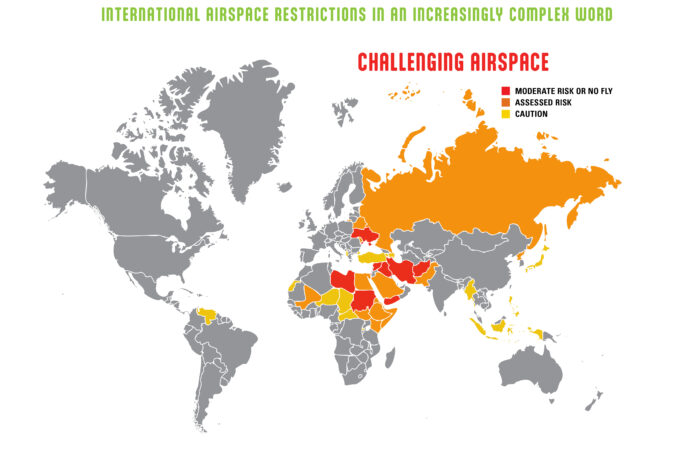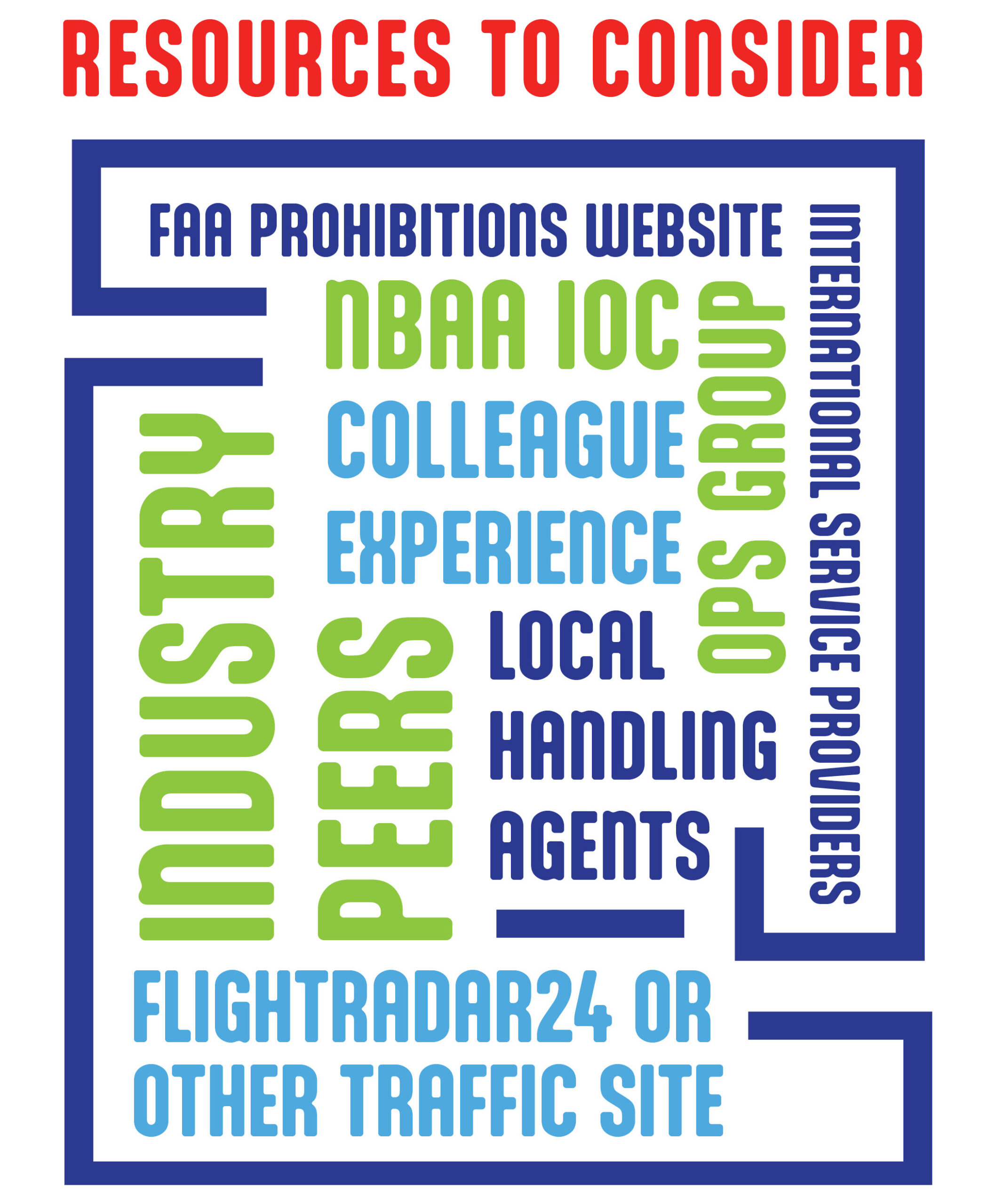Back in 300 BCE, when the Greek mathematician Euclid was developing Euclidian geometry’s theorem – “the shortest distance between two points is a straight line“ – he certainly had no way of knowing how wrong his rule would be for those of us planning an international flight in the 21st century.
But today, with rapidly changing airspace restrictions, any flight of any length has a good chance of being anything but a straight line. And as the world of international business travel returns to its pre-pandemic levels, the challenges of getting from here to there are only increasing.
“The desire for international travel has certainly expanded for us,” explained Chad Patnode, flight operations manager for Pfizer. “Really, as of about a year ago, when China fully re-opened after COVID, we’ve been back to a fully global operation.”
While the desired pre- and post-pandemic departure and arrival destinations have remained basically the same, the steps required to plan and complete these trips are vastly different.
“Flight planning has changed a lot from four years ago,” Patnode continued. “Airspace restrictions have meant we’re having to relearn how to safely get from point A to point B with all the uncertainty that’s out there.”
“For example, you can’t appreciate how big Russia is until you have to avoid its airspace. That’s really impacted us,” Patnode said. “We have flights now that are hours longer than they used to be, so we sometimes have to plan now for added fuel and crew swap stops.”
Nathan Shelley, assistant manager of flight planning operations for Universal Weather and Aviation, Inc., echoed Patnode’s comments and added, “We’ve become very quick to respond to changes and have had to use a lot of outside-the-box thinking since the closure of Russian airspace and turmoil in the Middle East.

Map courtesy of OPSGROUP/SafeAirspace.net (2/4/24)
“The Great Circle Route has always been our routing of choice, but now we have to avoid it all,” Shelley continued. “Even operators flying the North Pacific Region have to stay away from the Kamchatka Peninsula. It may not look like much on a map, but it can be a big deal in January when you encounter the headwinds in that region. It’s doable, but you have to be very adaptable.”
Start Planning Early
Patnode and Shelley stressed the need to start your international flight planning well in advance of a flight.
“With regards to flight planning and setting passenger expectations, we’ve become over-communicative with our customers these days,” Shelley said. “As their international service provider, clients rely on our experts to be their know-all and tell all, and we always strive for that level of performance. Today, it just takes more time and effort to collect all the details.”
“We’ve always been the kind of operator that does our trip planning well in advance, but today the planning starts at the reservation stage, several months out or longer,” Patnode explained. “We’re especially mindful of trips to countries where we may not have flown to since pre-COVID. So much has changed that can impact a trip.
“Flight planning has changed a lot from four years ago. Airspace restrictions have meant we’re having to relearn how to safely get from point A to point B with all the uncertainty that’s out there.”
CHAD PATNODE, Flight Operations Manager, Pfizer
“Once we learn of a trip, we try to involve the passengers and their administrative team early on and make them part of our planning,” Patnode continued. “If they’re going to meet with government leaders, those kinds of meetings are set in stone far in advance. We might suggest we leave a day or two earlier than they may have thought.
“Or if they’re doing a multi-city trip, we may be able to re-order those stops so they’re more efficient flights,” Patnode said. “But if you wait until all of their schedules are arranged, it’s complicated to make changes and not inconvenience our passengers.”
Both Patnode and Shelley stressed the importance of informing passengers about the need to detail every day’s activities.
Of course, knowing the departure, destination and arrival details is just the beginning of your international odyssey. Gone are the days of tapping that information into your software of choice and having it supply a usable flight plan.
However, there are online tools that can be helpful to your planning efforts. For example, Shelley said Universal Weather and Aviation now has a “trip feasibility” tool that operators can use.
“It’s become a huge thing for our clients when it comes to things like which countries you will have to fly over or near,” Shelley explained. “Can you comfortably get from here to there? For example, on one popular route, there’s a small sliver of Afghanistan that you will fly over – it only takes five minutes – but you need to know about what you may be dealing with.”
“We coordinate with our trip handlers and international service providers and start running draft flight plans through our team early,” Patnode said. “I’ll also go to FlightAware and see what routes the airlines are taking, and we’ll contact other operators that we know have recently gone to the same destinations to see what they can offer.”
Anticipate Changes
Of course, when it comes to long international trips, the actual flight plan is just one part of the puzzle. No matter how well you plan, things will always change. Weather, medical emergencies, mechanical issues and executives’ schedules are just some things you may have to deal with on the fly.
“We’re not just looking at departure and arrival airports,” Patnode said. “We have to pre-plan for alternate airports along the route. There aren’t a ton of options when operating in the Middle East today when a good day turns bad.”
 Now that long flights are getting longer, there can be issues with deciding where to locate replacement crews or where you can have longer layovers. Not all airports are the same.
Now that long flights are getting longer, there can be issues with deciding where to locate replacement crews or where you can have longer layovers. Not all airports are the same.
“Operating into smaller airports in other countries is far different than in Western Europe and the U.S.,” Shelley said. “Do they have quality fuel, or will you need security for your aircraft? There are many elements in play outside of the actual flight itself.
“Oftentimes, the actual flight planning is the most predictable part of any long trip,” he added. “There are just so many other moving pieces to an international trip today.”
“Knowing all the details will help your passengers avoid disruptions and increase your flight department’s value,” Patnode said. “Even a simple international trip is complicated today. In my experience, the executives on the airplane truly appreciate our help with making their travel easier.”
Review NBAA’s international flying resources at nbaa.org/intl.



 International Business Aviation Council Ltd.
International Business Aviation Council Ltd.